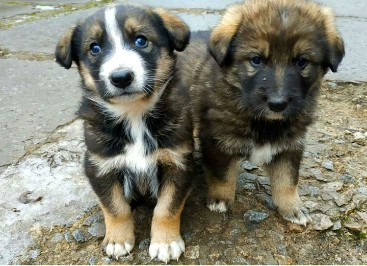Radioactive Dogs: Chernobyl, Ukraine

April 25, 2023
Did you know that most dogs who get radiation poisoning acquire enteritis, and only live for about 9 months? Now, what if I told you there was a group of stray dogs who managed to stay alive in a radioactive place called Chernobyl in Ukraine? They managed to breed and survive off of scraps in an area of the world that suffered through a radioactive level 7 accident (the highest level on the International Nuclear and Radiological Event Scale). This area has been uninhabited since 1986, and is currently labeled as the “exclusion zone”. This is the strange phenomenon of the dogs abandoned by their owners in Chernobyl, Ukraine. Some people believe them to be radioactive themselves, and though it’s not the worst of Ukraine’s troubles, the dogs saved are currently up for adoption to Ukraine civilians.
The dogs in Chernobyl are strays that were abandoned by their owners when fleeing the area when the world’s largest nuclear disaster occurred in an area of Ukraine, formerly part of the Soviet Union, the Chernobyl Nuclear Power Plant (CNPP). It was the 26th of April in 1986 when such an incident happened which shocked the world. It was the result of a flawed reactor design that was operated by untrained personnel. The explosion released about 5% of the radioactive reactor core into the environment. Two workers died, and 28 died later due to acute radiation syndrome. Scientists claim that about 5,000 people acquired thyroid cancer; however, they say that “there is no evidence of a major public health impact attributable to radiation exposure 20 years after the accident.” About 350,000 people evacuated Chernobyl, and most who had dogs left them behind. As of the 24th of February, Russian forces took control over the area, and as of March 9th, the power plant was disconnected from the power grid. But what happened to the dogs that were abandoned there?
The dogs have survived off of scraps that they could find for 37 years. They sleep in abandoned buildings and beg tourists for their scraps, and with the little they can get they manage to live, and also manage to breed together through multiple generations. Scientists are not sure how they have managed to survive, and have studied the genomes of 302 of the dogs living in Chernobyl. They came to a realization that the dogs living their genetics were genetically distinct from those who live a mere couple miles away. Most of the dogs living here are purebred, and a large number of them are German Shepherds, whereas the dogs living a few miles away in neighboring cities were mostly mix-bred. Some people theorize that the dogs themselves are radioactive, and are scared to go near them for that reason. They believe they are dangerous, and should not be rescued. However scientific studies claim that there are no genetic mutations, and are in no way different from other dogs. In fact, most of the radiation is simply on their fur, and when washed off, the dogs are completely harmless. As mentioned previously, scientists are still not sure how these canines have managed to survive such harsh conditions, considering they found traces of the radiation even in North America. Birds and bees around the area suffered from health issues. More studies are being made today to learn about this.
Although there is no such thing as a “radioactive dog,” the dogs in Chernobyl, Ukraine have managed to survive a terrible radiation explosion, scientists still aren’t sure how they are surviving to this day in harsh environments since the disaster in Chernobyl. What do you think of this issue? How do you think the dogs are unaffected by the radiation, yet animals like birds and bees suffer from many health issues? Let me know your opinion here in this Google Form if you have one!
Works Cited
ADVANCES, SCIENCE. “The dogs of Chernobyl: Demographic insights into populations inhabiting the nuclear exclusion zone.” ScienceAdvances, 3 3 2023, https://www.science.org/doi/10.1126/sciadv.ade2537. Accessed 14 3 2023.
“Chernobyl | Chernobyl Accident | Chernobyl Disaster.” World Nuclear Association, https://world-nuclear.org/information-library/safety-and-security/safety-of-plants/chernobyl-accident.aspx. Accessed 14 March 2023.
Sullivan, Will. “Why Scientists Are Studying the Stray Dogs Living at Chernobyl.” Smithsonian Magazine, 8 March 2023, https://www.smithsonianmag.com/smart-news/scientists-study-the-genetics-of-dogs-living-near-chernobyl-disaster-site-180981748/. Accessed 14 March 2023.




